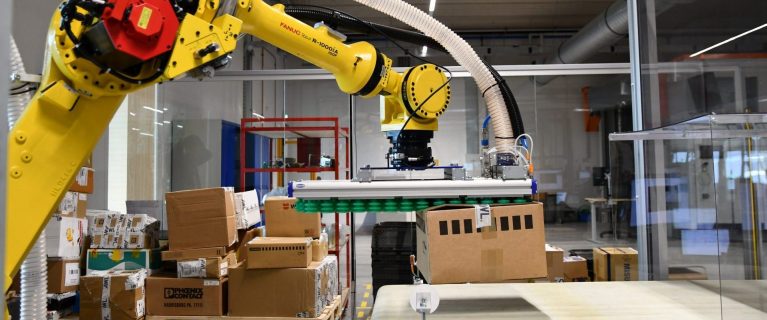Depalletising refers to the process of unloading bags or boxes from a pallet. Traditionally, it involves a strenuous set of physical activities, such as heavy lifting, bending, and stretching repetitively. This physical exertion could prove to be dangerous, if the package is over 25kg.
In fact, manual pickers are under constant pressure to lift objects of different sizes, shapes, loads, etc. This Stock Keeping Unit (SKU) variation skyrocketed with the rise of e-commerce in 2020.
Moreover, the requirement for manual labour in warehouses rose to 1.2 million in the US. Amidst that, social distancing and quarantine measures also posed huge roadblocks. Due to all those factors, automating the depalletising process seemed to be a reliable option.
Limitations with traditional depalletising methods
Previously, robotic technology was limited to picking items of similar attributes. Due to this, the pre-programmed system could not cope with SKU variations. Generally speaking, human pickers are experts in identifying and handling SKU variations, even with mixed-SKU pallets.
There is no denying the fact that humans are gifted with cognitive intelligence to locate the item, pick it at their own pace, and place it accordingly. In order to achieve accurate performance, warehouse workers are bound to undergo job and safety training.
Despite following an intended training module, they are still at risk of falling prey to chronic physical ailments. According to a report by the University of North Carolina, more than 36% of manual workers in the warehouses account for back and shoulder injuries, leading to missed workdays due to lifting and handling heavy objects.
Human workers at risk cost companies injury claim expenses, safety training, and legal compliance costs, contributing to a high turnover rate. Besides, the companies tend to juggle between hiring new workers and delivering consistent or even better throughput outcomes.
Some other common concerns with manual handling include physical constraints, lack of supervision, and poor ergonomics. As a result, there was a need to build a reliable depalletisation cell, free from human pickers.
Automating the depalletising process is not elusive, as it was before. Thanks to deep-learning algorithms, warehouses can now employ a suitable robotic depalletising cell with a cutting-edge vision system and an appropriate gripper to lift the heaviest of objects.
Things to consider
Essentially, manual pickers do not optimally use the warehouse working space. Installing robust depalletiser cells in warehouses can efficiently utilise the designated area, both the floor and the vertical space. Moreover, this can accelerate the overall performance by enabling manual workers to focus on other value-adding tasks. Otherwise, for instance, if three out of six workers performed depalletising operations along with multiple other duties, the depalletising station would suffer.
On the other hand, a robotic depalletiser features 3D vision systems and a gripper for pick-and-place depalletising operations. The 3D machine vision systems consist of multiple cameras, vision software, and laser sensors. Not only does it capture the environment, but a cutting-edge 3D vision system also calculates the coordinates of randomly placed objects.
It allows robots to scan each object, recognise their pick point, and place the item on a conveyor belt. After all, recognising unknown objects placed at different heights is a clear-cut step. Even detecting a box with tapes as a single item instead of six separate boxes is possible with the advanced robotic depalletiser cell.
Lastly, installing robust vision software integrates hardware and software components seamlessly for a robotic depalletising cell. The vision software can improve the accuracy of segmenting objects and enable robots to pick heavy objects from a random stack. Fizyr’s vision software is a plug-and-play product used by system integrators as a module to even deal with closely stacked and overlapping boxes.
Automating depalletisation with vision technology
Robots can effortlessly unload overlapping items or shiny objects, thanks to AI-driven vision technology and machine-learning algorithms.
This advanced vision software allows a robotic depalletiser to seamlessly handle a continuous flow of mixed-SKU pallets in any sequence. It can easily identify the item on the pallet, recognise the variations, and manage them accordingly.
The cutting-edge vision software segments the item, classify it and proposes over 100 grasp poses based on the trained neural network, enabling robots to move faster in challenging environments. Broadly, it alleviates common manual handling mishaps, while also maintaining a predictable throughput rate.
Whether mixed-SKU pallets or multiple pallets of the same SKU, automated robotic depalletising enhances productivity, reduces operating costs, and creates a safe working environment. That said, warehouse staff are less prone to chronic illnesses, injuries, and other health detriments. Best of all, the company can reap the benefits of both artificial and human cognitive intelligence.
IMAGE CREDIT: AWL











